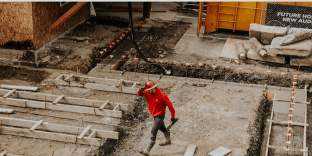
Soundproofing After Wall Removal
The Effect of Successful Soundproofing After Wall Removal Renovations
Load bearing wall removal is becoming a popular choice for homeowners looking to maximize space and modernize their homes. However, the newfound openness often comes with an unexpected issue: noise. If you’re grappling with managing acoustics in open layouts or planning a renovation, understanding how to implement effective soundproofing after wall removal is crucial.
While open layouts enhance connectivity and aesthetics, they also create unique challenges in managing acoustics. Without structural walls to act as natural barriers, voices, footsteps, and other sounds can echo, disrupt conversations, and diminish the comfort of the space. Either way, the lack of division often results in an increase in sound transmission.
Why Soundproofing Matters in Open Concept Homes
When removing structural walls, the lack of natural acoustic barriers can lead to several issues:
- Increased Noise Levels: Conversations in one area can easily carry to another, reducing focus and quietude.
- Reduced Privacy: Activities like watching TV, making phone calls, or even simple daily tasks can become intrusive.
- Echoes and Reverberations: Hard surfaces in open spaces amplify sounds, creating a less comfortable and sometimes overwhelming environment.
- Disrupted Family Dynamics: Excessive noise can strain interactions and reduce the enjoyment of shared spaces.
To enjoy the aesthetic and functional benefits of your renovation, it’s essential to prioritize soundproof renovations structural walls to create a balanced and quiet peaceful experience.
Solutions for Soundproofing After Wall Removal
1. Acoustic Insulation for Open Floor Plans
One of the most effective strategies for noise control in wall removal projects is to integrate acoustic insulation:
- Ceiling Insulation: Adding sound-absorbing materials like mineral wool or acoustic panels to ceilings can significantly reduce noise transfer. These materials are particularly effective in multi-level homes.
- Floor Treatments: Consider underlayment solutions, such as cork or foam, beneath flooring to dampen sound. Carpeting or area rugs with thick padding can further enhance volume control.
- Wall Enhancements: If partial walls or new partitions are introduced, ensure they include acoustic insulation to further optimize soundproofing.
By combining these methods, you create a buffer that manages sound more effectively across your open layout.
2. Strategic Use of Acoustic Barriers
When removing walls, consider incorporating design elements that double as soundproofing aids, such as:
- Bookshelves or Partition Walls: Tall bookshelves, especially when filled with books or decorative items, act as excellent sound absorbers and maintain the open aesthetic.
- Curtains and Drapes: Heavy fabrics help to absorb sound, particularly in areas with large windows. In fact, acoustic curtains specifically designed to dampen noise offer a stylish yet functional solution.
- Rugs and Soft Furnishings: Layering rugs and adding upholstered furniture dampens sound naturally. Choose plush materials for maximum effect.
3. Quiet Home Renovations with Soundproof Materials
Innovative materials designed specifically for soundproofing can make a significant difference:
- Mass-Loaded Vinyl (MLV): A versatile material that’s easy to install on walls, ceilings, and floors. It’s particularly effective for high-traffic or noisy areas.
- Acoustic Drywall: Thicker than standard drywall, it’s a practical solution for minimizing sound transmission. It can also be combined with other materials for enhanced performance.
- Resilient Channels: These create a gap between drywall and studs, reducing vibration and noise. They’re ideal for sound absorption between floors in multi-story homes.
4. Noise-Reducing Strategies During Renovations
Planning ahead during your renovation project can save time and effort. Our team at Load Bearing Wall Pros recommends:
- Pre-Construction Consultation: Evaluate potential acoustic challenges before the project begins. This ensures tailored solutions are implemented from the start.
- Precision Execution: Ensure all materials are installed correctly to maximize their soundproofing benefits. Misaligned or improperly installed insulation can reduce the effectiveness of noise muffling.
- Custom Solutions: Tailor strategies to your home’s unique layout and requirements. For example, a kitchen remodel that creates an open living space requires different acoustic treatments than connected dining and office areas.
5. Ongoing Noise Management Post-Renovation
Even with the best materials, regular maintenance helps ensure long-term comfort:
- Seal Gaps and Cracks: Use acoustic sealants to close any openings that may allow sound leaks, particularly around windows and doors.
- Furniture Placement: Strategically place furniture to disrupt sound paths. For example, a large sectional sofa can act as a barrier.
- Evaluate and Update Insulation: Periodically check the condition of soundproofing materials and upgrade them as needed to maintain optimal performance.
“Soundproofing isn’t just about materials – it’s about understanding how sound moves through your space. Our goal is to give homeowners open layouts that are both functional and serene.” – Jason Hulcy, Founder of Load Bearing Wall Pros
Our expertise in wall removal projects ensures every aspect of your renovation is thoughtfully planned and executed to meet your needs. From consulting on material choices to precision installation, we bring a comprehensive approach to every project.
Additional Soundproofing Tips for Unique Challenges
For homes with specific acoustic needs, implementing targeted solutions can significantly improve sound control. Let’s explore these specialized approaches in detail:
Drop Ceiling Solutions
Also known as a suspended ceiling, it creates an air gap between the original ceiling and the new surface, providing excellent sound dampening. When installing one, consider:
- Installing acoustic batts in the cavity between ceilings
- Adding mass-loaded vinyl above the tiles for enhanced sound blocking
- Ensuring HVAC and lighting fixtures are properly sealed to prevent sound leakage
- Using isolation clips and channels to prevent sound transfer through the ceiling grid
Soundproof Door Implementation
While standard hollow-core doors offer minimal sound protection, specialized soundproof doors can reduce noise transmission even more. Key considerations include:
- Installing high-quality acoustic door seals on all four sides
- Using automatic door bottoms that drop when the door closes
- Adding door gaskets and sweeps to eliminate air gaps
- Considering double-door systems for maximum sound isolation in critical areas
Strategic Zone Creation
Thoughtful space planning can significantly impact acoustic performance. Consider these approaches:
- Installing floor-to-ceiling bookcases filled with books to absorb sound
- Positioning large, upholstered furniture pieces strategically to break up sound waves
- Creating dedicated quiet zones with acoustic curtains or sliding panels
- Using plants and vertical gardens as natural sound diffusers
Special Considerations for Different Room Types
Different spaces require tailored approaches:
- Home Offices: Focus on speech privacy and external noise reduction
- Media Rooms: Address both sound containment and internal acoustics
- Bedrooms: Emphasize low-frequency noise control and sleep-friendly environments
- Bathrooms: Handle echo reduction and plumbing noise isolation
Budget-Conscious Solutions
When working with limited resources:
- Phase implementations starting with the most critical areas
- Combine aesthetic elements with acoustic functions
- Use DIY solutions where appropriate, such as custom acoustic panels
- Focus on sealing gaps and leaks before investing in expensive materials
By addressing these unique challenges comprehensively, you can create a more comfortable and acoustically balanced living space that meets your specific needs while maintaining the aesthetic appeal of your open-concept design. Regular assessment and maintenance of these solutions will ensure their continued effectiveness over time.
FAQs About Soundproofing After Wall Removal
Q: How do I prevent echo in my open concept home?
A: Use soft furnishings, area rugs, and acoustic panels to absorb sound and minimize echo. Placing wall hangings or canvas art with sound-absorbing backing can also help.
Q: Are there affordable soundproofing options for renovations?
A: Yes! Curtains, rugs, and strategic furniture placement offer cost-effective ways to manage noise. For DIY enthusiasts, soundproofing foam panels can be an economical choice.
Q: Do I need professional help for soundproofing?
A: Professional input ensures optimal results, particularly for complex projects like load bearing wall removal. Experts can identify challenges you might overlook and offer customized solutions.
Why Choose Load Bearing Wall Pros for Quiet Home Renovations?
We specialize in transforming homes through structural modifications that enhance both style and comfort. Our team’s expertise ensures:
- Seamless integration of noise-reducing strategies renovations.
- Tailored solutions for acoustic insulation open floor plans.
- Thoughtful planning for quiet home renovations that prioritize your peace of mind.
Final Thoughts on Soundproofing Open Spaces
Soundproofing is an essential aspect of modern open layouts. By prioritizing acoustic comfort, you not only enhance the functionality of your home but also ensure a peaceful and enjoyable living environment. Whether you’re in the planning phase or looking to upgrade an existing space, we have the expertise to guide you every step of the way.
Ready to turn your open layout into a serene haven? Contact Load Bearing Wall Pros today to discuss your soundproofing needs. Let’s make your dream open concept home a reality – without compromising on comfort.
About the Author
Jason Hulcy, the founder of Load Bearing Wall Pros, is a seasoned expert in wall removal and home renovations. With a passion for innovation and sustainability, he has helped countless homeowners achieve their dream spaces safely and efficiently. Learn more about his expertise here.


